Hydrogen is fast becoming a key enabler in the global transition toward cleaner industrial practices. As nations race to meet net-zero goals and industries face increasing pressure to decarbonize, hydrogen stands out not only as an energy carrier but also as a versatile industrial input. From acting as a high-temperature fuel to serving as a clean feedstock, hydrogen offers a compelling proposition for hard-to-abate sectors.
Why Hydrogen Matters in Industrial Decarbonization
Hydrogen brings unique advantages to industrial processes, especially those that are energy-intensive or heavily dependent on fossil fuels. Here’s why it’s gaining traction:
- High-temperature heat source without carbon emissions: Hydrogen combustion generates heat without producing CO₂, making it ideal for processes that require temperatures exceeding 1,000°C.
- Clean feedstock for critical chemicals: Hydrogen is a fundamental raw material in the production of ammonia, methanol, and other industrial chemicals.
- Flexible energy storage medium: Hydrogen can store excess renewable electricity, converting it back into power or other usable forms of energy when needed.
Sector-Wise Industrial Applications
1. Steel Industry
The steel sector accounts for nearly 7–9% of global CO₂ emissions. Traditional blast furnace methods use coking coal to reduce iron ore, emitting massive amounts of carbon. Hydrogen, particularly green hydrogen, can replace coal in Direct Reduced Iron (DRI) processes. When hydrogen reacts with iron ore, the by-product is water vapor instead of CO₂—cutting emissions by up to 95%. Companies like ArcelorMittal and SSAB have already launched pilot projects to test hydrogen-based steel production at scale.
2. Ammonia & Fertilizer Manufacturing
Ammonia production is currently one of the largest consumers of hydrogen, most of which is derived from fossil fuels (grey hydrogen). Transitioning to green hydrogen can significantly reduce the carbon footprint of the fertilizer industry. Moreover, ammonia is also being considered as a hydrogen carrier, given its ease of storage and transportation, further extending its utility beyond agriculture.
3. Refining & Petrochemicals
Hydrogen is an essential component in refining processes like hydrocracking and hydrotreating. Refineries currently rely on grey hydrogen, contributing significantly to Scope 1 emissions. Replacing it with green hydrogen can decarbonize the sector without altering the core chemical pathways. Petrochemical companies are also exploring hydrogen as a feedstock for plastics and other chemicals.
4. Glass & Ceramics
These sectors require extremely high temperatures in furnaces and kilns—traditionally met with natural gas or oil. Hydrogen combustion offers a clean substitute. European manufacturers have begun testing hydrogen furnaces that can maintain the required heat levels while drastically reducing emissions.
5. Electronics & Pharmaceuticals
Ultra-high purity hydrogen is critical in the manufacture of semiconductors, electronics, and pharmaceutical intermediates. In these industries, hydrogen is used as a reducing agent and carrier gas. With the rise in domestic and global chip manufacturing, demand for green, high-purity hydrogen is expected to surge.
Strategic Benefits for Industrial Players
- Lower Scope 1 and 2 Emissions: Switching to green hydrogen helps organizations comply with tightening emissions regulations while lowering their carbon footprint.
- Stronger ESG & Brand Positioning: Early adopters of hydrogen technologies can position themselves as sustainability leaders.
- Access to Green Incentives: Governments across the globe, including India, are offering subsidies, production-linked incentives (PLI), and tax benefits for clean hydrogen adoption.
Implementation Challenges
Despite its potential, hydrogen adoption is not without challenges:
- Infrastructure Gaps: Industrial-scale hydrogen transport and storage infrastructure is still developing.
- Retrofitting Costs: Existing systems, such as boilers or furnaces, may require upgrades or redesigns to accommodate hydrogen.
- Talent & Skill Shortages: Safe handling and deployment of hydrogen systems need a specialized workforce, which is currently limited.
Practical Solutions for Seamless Integration
To bridge these gaps, a number of solutions are being rapidly developed and deployed:
- On-Site Hydrogen Generation: Companies can install compact, skid-based hydrogen generation units to eliminate the need for transport and ensure uninterrupted supply.
- Modular Skid Systems: These allow scalability—start small and expand production as demand grows without major infrastructure overhaul.
- Automation & Safety: Integration of IoT sensors, PLC-based automation, and AI-powered monitoring systems ensures safe, efficient, and real-time control of hydrogen systems.
Conclusion
Hydrogen is not just a buzzword—it’s an industrial revolution in the making. For sectors like steel, chemicals, electronics, and glass, hydrogen offers a scalable, clean, and economically viable path toward decarbonization. Companies that begin integrating hydrogen into their operations today will be better positioned to meet future regulations, attract sustainability-focused investors, and lead in the global clean-tech transition.
At Hydrogen Gentech Private Limited (HGPL), we help industries navigate this shift by offering end-to-end hydrogen solutions—from modular skids and purification units to EPC services. If you’re planning to future-proof your industrial processes, hydrogen is the strategic lever you need to pull—today, not tomorrow.











